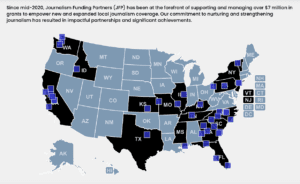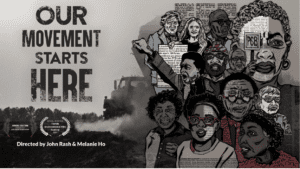By Eric Frederick, NC Local newsletter editor
[Also in the Jan. 13 edition: A campaign to save the historic Wilmington Journal, and shoutouts for a dozen recent examples of strong NC journalism. Sign up to get NC Local in your inbox each week]
The insurrection a week ago at the Capitol was yet another call to duty for North Carolina’s local news and information providers. Obviously, stories just don’t get much more important than this one — and it has hundreds of local tendrils.
People are anxious. They need reliable information on what’s happening. And there’s a very good chance that there’s more unrest to come — and closer to home.
I consulted a lot of smart folks over the past few days and pulled together a few tips, plus some good work and some things to think about:
Ways to build trust
‘While we don’t know what the next few days and weeks will entail, we know this is far from over. And as journalists, it’s an important moment for us to convey credibility.’
Mollie Muchna, for Trusting News, offers several useful guidelines for keeping faith with readers while covering civil unrest. The key points:
◼️ Be thoughtful about your word choice (more sources on that below).
◼️ Explain that you’re on the side of facts.
◼️ Quickly correct misinformation (including your own errors).
◼️ Show consistency in your approach (and your organization’s approach).
◼️ Discuss content you share but was produced by others, and why you trust it.
◼️ Explain how breaking news works.
◼️ Explain what you’re up against.
Some challenges to consider
‘We need to understand not only who was there, but why…’
Megan Squire sees a specific role right now for local media. Squire, a professor of computer science at Elon, studies niche online communities on platforms such as DLive and how extremists use them to spread hate and make money. Reading her Twitter posts is like following a detective drama.
“It would be helpful for local news media to keep track of the arrests from our state, and also to track and expose individuals and groups that attended or aided in the insurrection,” she told me, “particularly if those people are in positions of power such as police officers, military members, elected officials, government workers and the like.
“We need to understand not only who was there, but why. What other ideologies do they hold? What types of issues led them to take this action? What types of local groups were involved? For example, were they involved in the ‘re-open’ movement, Confederate monument support, Second Amendment support, and so on.”
◼️Examples of media reporting on local participants:
➵ The evolving story of Capt. Emily Rainey at Fort Bragg: Army investigating officer who led group to Washington rally. Jake Bleiberg, Sarah Blake Morgan and James LaPorta for The Associated Press.
➵ North Carolina extremists pledge to escalate beyond DC insurrection. Jordan Green, Triad City Beat. (BTW, check out Green’s rather prescient piece for Raw Story before the riot.)◼️ And here is Al Tompkins’ take on this issue for Poynter:
➵ Should journalists play a role in identifying rioters?
◼️ Some other good work I’ve seen that illuminates local elements of this story:
➵ Police keep eye out in Raleigh amid threats, return of lawmakers. ‘They’ll be ready.’ Josh Shaffer and Danielle Battaglia, The News & Observer and The Herald-Sun.
➵ ‘This isn’t a normal class’: NC teachers help students process US Capitol riots the day after. Brian Gordon, USA Today Network in North Carolina.
On language
Yes, words matter.
◼️ Don’t use militarized language. Avoid labels that lump people together. And put everything in context. Jennifer Brandel of Hearken introduces the Election SOS First Aid Kit: Messaging on Violence.
◼️ The words you apply to people and groups can overgeneralize, Joy Mayer of Trusting News reminds us. Take care — and be transparent about your choices.
◼️ “Language that pushes the boundaries of traditional neutrality can be used in a responsible news report.” Read Roy Peter Clark’s take for Poynter.
Help people understand the issues
Social media restrictions, the First Amendment and censorship — obviously a deep well of misunderstanding.
Tori Ekstrand, an associate professor of media law in the UNC Hussman School, is an expert on the topic — and she addresses it, and four other key issues, while sharing her five key talking points for the first day of the spring semester in her Introduction to Media Law class. She’s an excellent resource.
➵ Ekstrand also points us to this overview of media law issues raised by the insurrection, from the Silha Center for the Study of Media Ethics and Law at the University of Minnesota.
A real community service
Some useful thoughts about one thing local journalists can do next is in this thread by DaLyah Jones, who reports on environmental justice and writes about Southern arts and culture for the Texas Observer; she’s also a former Freedomways Fellow at Press On. The gist: Communities need to know how to acquire and share information, and journalists can help them learn (and she’s eager to help, if you want to reach out).
Be prepared, and be safe …
It’s more obvious than ever that journalists can be targets of the violence they’re covering — and the danger seems to have grown. Below are some sources of help that we shared during the summer unrest, and some new ones:
Resources:
◼️Here are 23 guidelines for journalists to stay safe while covering unrest, from Al Tompkins at Poynter.
◼️ The Committee to Protect Journalists offers this guide to being ready and safe.
◼️ Here’s the Legal Defense and FOIA Hotline offered by the Reporters Committee for Freedom of the Press.
◼️ The U.S. Journalism Emergency Fund, created by the International Women’s Media Foundation in partnership with Craig Newmark Philanthropies, offers financial help to journalists of any gender who have been targets of violence during political unrest. [Apply.]
◼️ The U.S. Press Freedom Tracker is keeping tabs on journalists who are being detained, assaulted or deprived of the tools of their trade. You can report incidents there.
Webinars:
◼️ The International Women’s Media Foundation is hosting a webinar Thursday at 7 p.m. ET on strategies for staying safe while covering violent unrest. [Register.]
◼️ The Dart Center for Journalism and Trauma, a project of the Columbia University Graduate School of Journalism, is hosting a free 90-minute safety training webinar for journalists on Friday at noon ET. [Register.]
And finally, this thought …
When the task of helping people stay informed and empowered seems too much…
My great friend Nation Hahn reminded me this week of something instructive — something that Ta-Nehisi Coates said to students at Davidson College in 2015, when one of them asked him about such daunting tasks:
‘Everything is not up to you; you can’t actually control everything. The weight of history is bearing down on you. … I encourage you to find your trade, practice that trade at a real high level, and direct it to the causes that you believe in. … People do see you, and you can speak truth, and people can turn around and say they saw something in that.’




